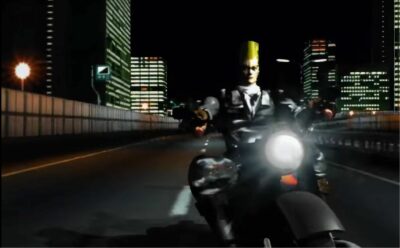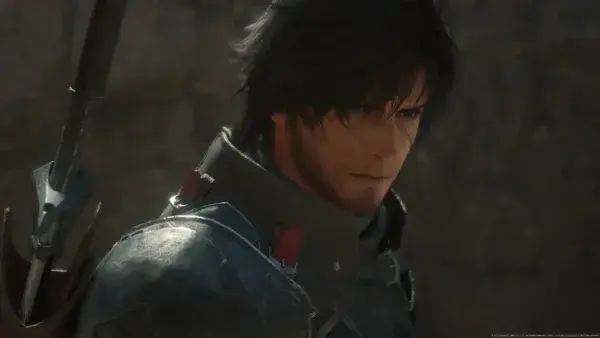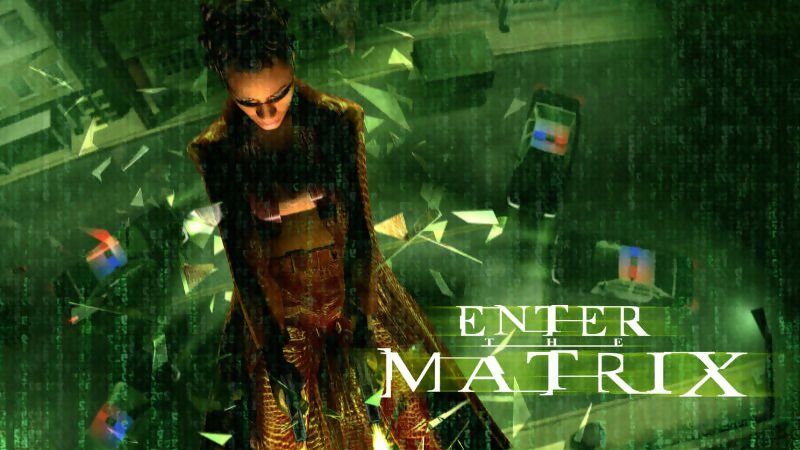
Twenty years ago, Enter the Matrix attempted to revolutionise the relationship between movies and their tie-in games. The developer’s only enemy was technology…
In the blockbuster movie sequel The Matrix Reloaded, Keanu Reeves’ Neo sends the crew of the hovercraft Logos off on an important mission to destroy a power plant. It seems like the set-up for a massive and destructive set-piece, full of the Matrix film series’ cutting-edge wire-fu and bullet-dodging special effects.
But, in the film at least, it doesn’t happen. Niobe (Jada Pinkett Smith) and Ghost (Anthony Brandon Wong) disappear from Reloaded’s narrative, only reappearing out of the blue during the famous freeway chase sequence. The spectacle at the power plant happens off-screen… because you have to do it.
Atari’s Enter the Matrix was released for PS2, Xbox, GameCube, and PC on the same day as Reloaded in May 2003. As envisaged by the films’ writers and directors the Wachowskis themselves, it was intended as an integral piece of a larger puzzle: the films, the game, animated series The Animatrix, a series of comics, and smart use of a website (a nascent marketing tool at the time) all designed to tell unique parts of a single story.
Casual viewers who only watched the films had enough information to stay up to speed. But to truly get the whole picture, dedicated Matrix fans needed to go deeper, and the Wachowskis fully encouraged that immersion.
This wasn’t a corporate plan dictated by studio Warner Bros. It was creator-driven. Thanks to the surprise, enormous success of the first Matrix movie in 1999, the Wachowskis were essentially given carte blanche to do whatever they liked next.
That turned out to be a hugely complicated and ambitious enterprise that arguably invented the notion of transmedia storytelling as we understand it today. It also turned out not really to be possible; resulting in Enter the Matrix feeling, at best, like a compromised glimpse of a fascinating potential future at which we hadn’t yet arrived.
BLUE PILL: THE VISION
It began with a script: specifically, an extra script that nobody was expecting. The Matrix Reloaded and The Matrix Revolutions were to shoot at the same time over a colossal 18-month schedule split between Los Angeles and Sydney. So when the Wachowskis delivered three screenplays to the studio, they were met with a certain degree of perplexity.
“[Warner Bros.] was like, ‘OK, well we understand this is [the second] sequel and [third] sequel, but what’s this other thing?’” laughs producer Rosanna Sun. “It looked just like a movie script, and it had all the same actors’ names and characters, scenes written out, the whole thing. They explained it was a game, and [Warner Bros.] didn’t really know what to do with that.”
The studio, via super-producer Joel Silver, brought in David Perry and his company Shiny Entertainment to develop the actual nuts and bolts of the gameplay experience. Perry isn’t sure how Shiny had ended up on the Wachowskis’ radar, but the pair were certainly gamers, so it’s likely that previous Shiny projects like Sacrifice and Messiah (both 2000) had caught their attention. It’s equally possible that they were fans of Earthworm Jim…
The cover of the game as eventually published boasted “Written and directed by the Wachowskis,” and Perry says that, the day-to-day aspects of programming and designing the levels notwithstanding, this is genuinely true in terms of “the story, the arc, getting everyone to think of Enter the Matrix as more than just a video game licence attached to a movie.”
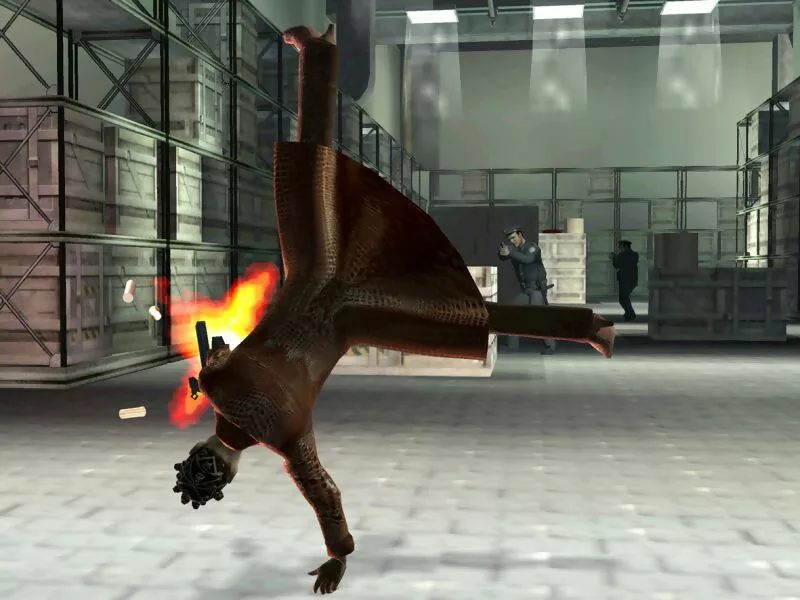
Enter the Matrix replicated the movies’ acrobatic gunplay in video game form. Unfortunately, Max Payne beat it to the punch by two years.
“Normally you get the licence, then you find out all the things the studio won’t let you do,” Perry continues. “For example, Shiny got to make a Terminator 3 game, but [the player couldn’t] be the Terminator or Sarah Connor, and we weren’t allowed to use their likenesses. Enter the Matrix was the exact opposite.
“The Wachowskis wrote an hour of new story and filmed it so we could have the video game really be a part of the Matrix story and give the players all that exclusive content. And Rosanna provided super-high bandwidth access to everything, including sets, props, actors, and motion capture. It kept everything authentic. We’d never made a game that way before. I don’t think there are many directors in the world that could contemplate the complexity of managing two sequel movies and a video game simultaneously.”
“Studios at that time weren’t – and still aren’t, to be honest – set up for that sort of integration,” adds Sun, whose specific producing role across the films and the game was one that had never really existed before she was forced to invent it. “You have different departments working separately, and they don’t know each other. I’d call one person from one department and one from another and get a conference line, and they’d be like, ‘Hey, never met you!’ They were all Warner Bros., but they’d never spoken before. There was a lot of that happening for the first time.”
The game takes place both before and during the timeline of The Matrix Reloaded, and begins in the immediate aftermath of the Animatrix short Final Flight of the Osiris. Niobe, the captain of the Logos, and Ghost, her first mate, first have to retrieve a package left behind by the Osiris. Having learned that the machines are heading for Zion, Niobe and Ghost gather the rest of the Zion fleet to hatch a plan for the resistance.

Enter the Matrix’s commitment to accurately recreating scenes and props from the film was rare in games at the time.
There’s some business with rogue Matrix programs the Keymaker (Randall Duk Kim) and the Merovingian (Lambert Wilson), and the constant threat of Agent Smith (Hugo Weaving) and his other agents, before the Logos crew liaise with Neo on the Nebuchadnezzar and then head off again to shut down that plant. After that, and a conversation with the Oracle (Mary Alice), there’s a final face-off with Agent Smith and some more raging against the machines, before we leave Niobe and Ghost preparing for the events of The Matrix Revolutions.
The gameplay differs slightly depending on whether you choose to be Niobe or Ghost – the freeway chase for Niobe is a driving section, for example, whereas for Ghost it’s a few minutes of on-rails machine-gunning – and levels take place across city streets, rooftops and sewers, an airport, a château and, er, a post office.
“That’s a good example of the challenge,” chuckles Perry. “The script would say we were going to be in a post office, so our team would end up in deep discussion: ‘How are we going to make a post office fun?!’”
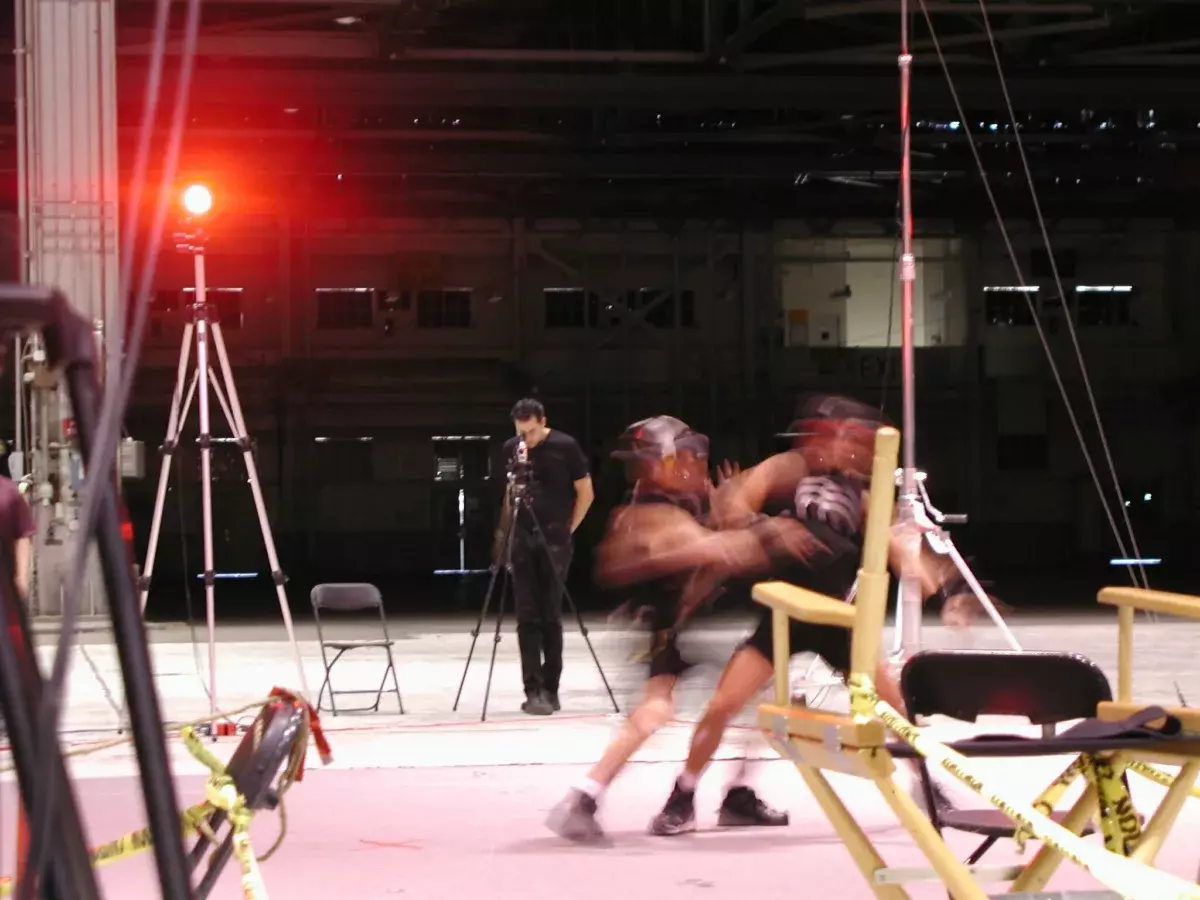
Enter the Matrix was far from the first game to use motion capture, but its use helped with the game’s cinematic feel.
Tie-ins had used films’ real stars before, but this was generally a simple case of actors spending a day or two providing voice-overs behind a microphone. For Enter the Matrix, filmed cutscenes, animated cinematics, and gameplay alike all used the genuine actors, film sets, costumes, and props, at least as reference.
The game had access to the films’ costume and production design departments, and the martial arts expertise of choreographer Yuen Woo-Ping. So hands-on were the Wachowskis that, when shown aspects of the game-in-progress that they hadn’t designed themselves, they would send crew out to rectify the situation, folding the game back into their own vision.
“David and his team would write in a location that you needed to find a hint or whatever,” Sun recalls. “And if it didn’t already exist for the films, we then had storyboard and concept artists work on it, and we even had our location crew go out at times. Our guys in Sydney would send me photographs in LA and say, ‘OK, well down the street from this building that we’re shooting at is this building… Could they use that for this?’
“It was almost integrated to the point of absurdity. You’re making something in CG, it doesn’t have to look like a real location, but the Wachowskis wanted everything to feel authentic. They felt that level of detail and attention would translate for the fans.”
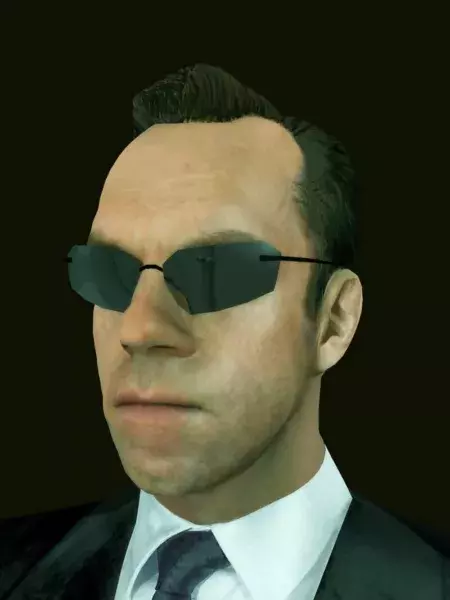
Agent Smith actor Hugo Weaving was among the prominent actors whose likeness was scanned and zapped into Enter the Matrix.
RED PILL: THE REALITY
Unfortunately, however, in spite of the immense resources at its disposal, nothing could ultimately defeat the game’s biggest enemies: technology and time. In 1999, The Matrix had blown people’s minds with its high-minded cyberpunk philosophising, Goth-metal chic, mind-boggling action sequences, and its then-cutting-edge visual effects.
But when it came down to it, at its core, Enter the Matrix ended up a rough-around-the-edges third-person action fighting game; intermittently fun, but never really replicating the movies’ ‘whoa’ factor. Thanks to the cultural saturation of the 1999 film, it even felt over-familiar: Rockstar’s Max Payne had co-opted the bullet-time mechanic two years earlier.
The Animatrix had complemented the film series through stylisation, but Enter the Matrix was attempting a photorealism that was nowhere near achievable, leading to some jarring transitions between the Wachowskis’ filmed vision and the game’s graphic interpretations. Fundamentally, 2003’s consoles weren’t up to the job of rendering the spectacle of The Matrix.
“The Wachowskis knew that they were pushing beyond what they’d seen in games up to that point,” says Sun. “So there was always going to be a push back… and we got to the point where, with all the film footage and the cinematics, we’d already filled up the disc before any gameplay had gone on.
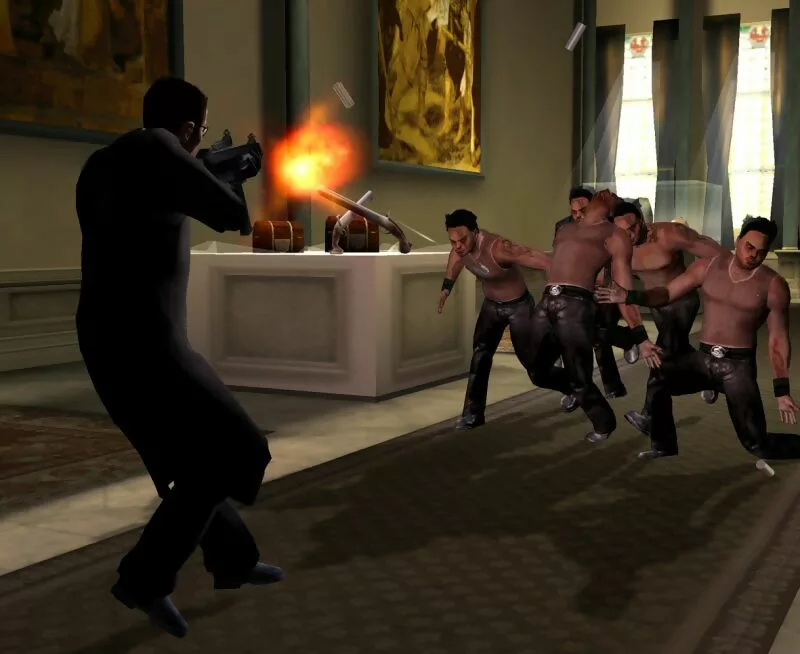
The character Ghost, as played by actor Anthony Brandon Wong.
“Some hard choices had to be made about how we were going to keep the fidelity of things that we had created in play. We really wanted to show the highest capability, and it just wasn’t there yet. That was the hardest, most heartbreaking part of the process for David and I and the team.”
Releasing the game day-and-date with Reloaded was also set in stone. Games companies are infamous for delaying launches if time for more development and testing is felt to be necessary, but Enter the Matrix simply didn’t have that luxury. “It was the highest pressure deadline we’d ever worked on,” Perry laments. “We just didn’t have the time needed to really invest into things like AI for smarter enemies.”
The game was heavily promoted, with trailers in cinemas, its own premiere party, and dozens of magazine covers (even extending to the front of the New York Times’ entertainment section). Sales were colossal – five million units sold, half of them in the first six weeks of release – but gamers and critics were largely, to put it mildly, underwhelmed.
As with the lukewarm response to the film sequels themselves, word of mouth was not strong, and sadly the reputation of Enter the Matrix almost 20 years later is one of disappointing compromise. Which is a shame, because it was a noble attempt to do something truly revolutionary, pointing the way to a future in which games based on films weren’t just pieces of tie-in merch; afterthoughts farmed out by studios to third parties for a soon-forgotten cash-in.
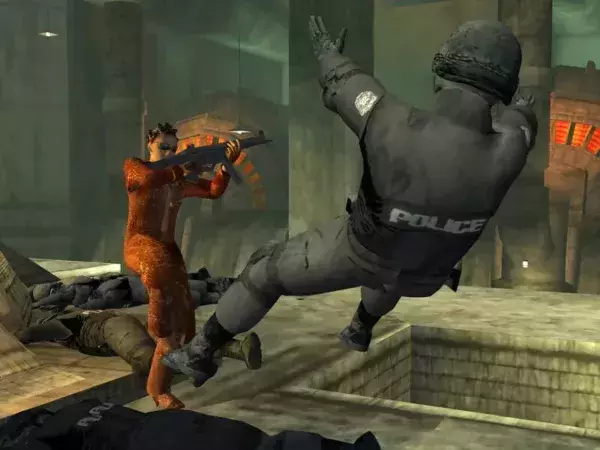
An early-2000s classic? Hardly, but Enter the Matrix’s ambitious merging with movies, comics, and other media made it stand out.
Sun says it amazes her that the integration of film and game studios for the sort of opportunities suggested by Enter the Matrix still isn’t anything like the industry norm. In fact, it’s rarely – if ever – happened since.
“I’m surprised that Marvel or Star Wars aren’t doing it,” she says. “They have the capability and the resources, but I think they see it as this mountain that, having been mostly unexplored, is just hard and expensive. Marvel is a perfect example of a studio that still creates a universe and then hands it off to someone else, and the video game company gets really excited if they get, like, one of the actors to do a voiceover.
“The integration we had was down to the bolts that were used. There were limitations, and some things fell short, but the idea was always to be the beginning of more. We wanted to put out the idea of how this could be done in the future…”
For a franchise concerned with prophecy, that seems completely appropriate.
A version of this article first appeared in issue 45 of Wireframe magazine.




